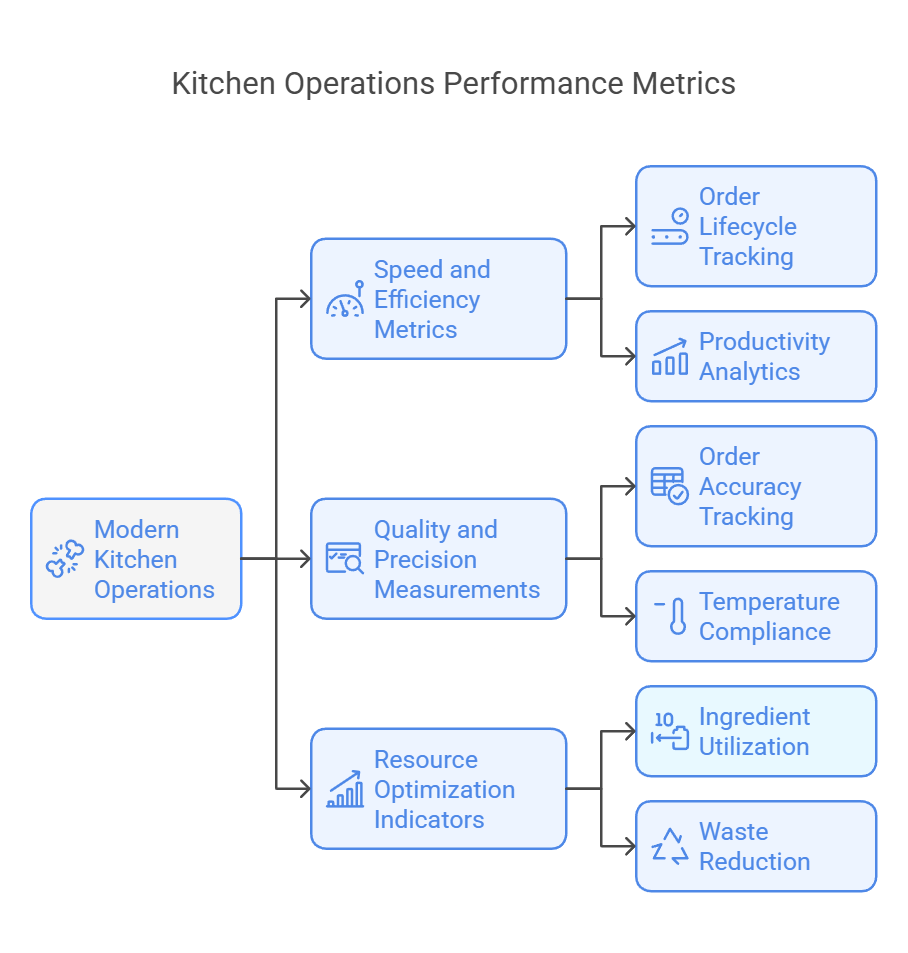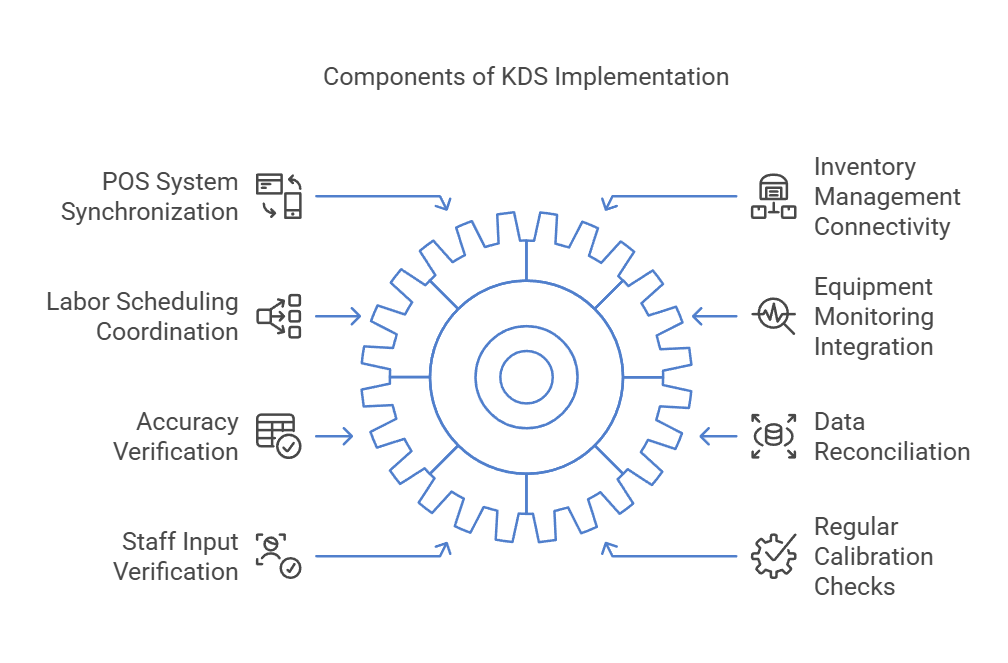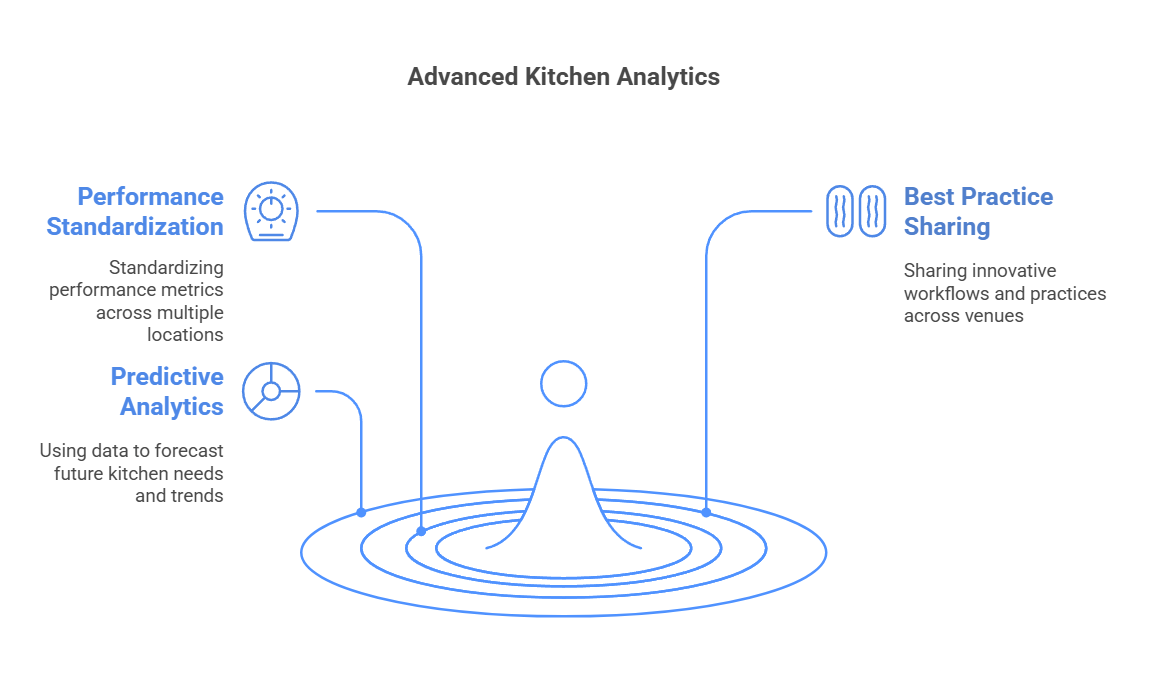
Kitchen Display Systems: Essential Metrics for Measuring Kitchen Performance Success
5 minute read
Kitchen Display Systems: Essential Metrics for Measuring Kitchen Performance Success
Article at a Glance:
- Transform Raw Data into Kitchen Excellence: Modern Kitchen Display Systems (KDS) go beyond basic order management to provide actionable performance insights that optimize operations and drive sustainable growth.
- Critical Performance Metrics: Learn how to track and analyze essential metrics across speed, quality, and resource optimization to create a comprehensive performance measurement framework.
- Data-Driven Decision Making: Discover how leading kitchens use KDS analytics to identify bottlenecks, optimize workflows, and make informed operational improvements based on real-time data.
- Advanced Analytics Integration: Explore sophisticated analysis techniques, including cross-location performance comparison and predictive analytics, to take kitchen operations to the next level.
- Building a Culture of Continuous Improvement: Understand how to implement and maintain an evolving measurement system that drives ongoing operational excellence.
For kitchen operators looking to maximize their KDS investment, this comprehensive guide provides practical strategies for implementing and leveraging performance metrics to achieve operational excellence and sustainable growth.
In the fast-paced world of commercial kitchens, a robust KDS system has revolutionized operations beyond simple order management. While many establishments implement these systems for basic functionality, the true power lies in their ability to transform raw data into actionable performance insights. This comprehensive guide explores how leading kitchens leverage kitchen display system metrics to drive operational excellence and sustainable growth.
The Hidden Power of Kitchen Performance Metrics
Gone are the days when kitchen success was measured solely by customer satisfaction and food costs. Today’s high-performing kitchens harness sophisticated KDS system analytics to orchestrate every aspect of their operations. By diving deep into performance metrics, kitchens can anticipate challenges before they emerge and optimize workflows with surgical precision.
When implemented thoughtfully, a robust kitchen display system measurement framework serves as the nervous system of your kitchen operations. It continuously monitors vital signs, alerts you to potential issues, and provides the insights needed for data-driven decision-making. This systematic approach transforms chaotic kitchen environments into well-oiled machines where efficiency and quality coexist harmoniously.
Essential Performance Metrics That Drive Kitchen Success

Speed and Efficiency Metrics:
- Order lifecycle tracking from receipt to completion
- Inter-station transfer velocity measurements
- Individual and team productivity analytics
- Peak period performance indicators
Quality and Precision Measurements:
- Order accuracy tracking across stations
- Temperature compliance monitoring
- Recipe consistency evaluation
- Special instruction execution rates
Resource Optimization Indicators:
- Real-time ingredient utilization patterns
- Equipment efficiency measurements
- Waste reduction metrics
- Labor allocation effectiveness
Building a Foundation for Measurement Excellence

Implementing an effective KDS system demands more than installing software and training staff. It requires a fundamental shift in how kitchens approach data collection and analysis. The journey begins with establishing clear baselines and creating a measurement framework that evolves with your operation.
Before diving into advanced metrics, document your current performance levels meticulously. This baseline data becomes your north star for measuring progress and identifying improvement opportunities. For instance, a kitchen might discover their average ticket completion time is 14 minutes during peak hours but drops to 8 minutes during slower periods. This granular understanding enables targeted optimization efforts rather than broad, ineffective changes.
The success of your kitchen display system hinges on seamless integration across multiple touchpoints:
Critical Integration Points:
- POS system synchronization
- Inventory management connectivity
- Labor scheduling platform coordination
- Equipment monitoring system integration
Data Validation Protocols:
- Systematic accuracy verification
- Cross-platform data reconciliation
- Staff input verification processes
- Regular equipment calibration checks
Transforming Metrics into Operational Excellence
Raw data alone doesn’t drive improvement – it’s the intelligent application of insights that transforms kitchen operations. When KDS analytics reveal consistent delays or quality issues, successful kitchens launch systematic investigations that cut through symptoms to address root causes.
Consider a kitchen struggling with prolonged preparation times during lunch service. Rather than making assumptions, they dig deep into their KDS system data. Through careful analysis, they discover that while individual station times remain consistent, orders frequently stall during hand-offs between stations. This insight leads them to redesign their kitchen workflow, resulting in significant reduction in total preparation time.
Strategic Performance Analysis Framework
Successful kitchen display system implementations rely on comprehensive analysis across multiple dimensions:
- Station-by-station timing analysis to identify bottlenecks
- Staff scheduling optimization based on peak period data
- Kitchen layout efficiency evaluation
- Equipment utilization assessment
Quality control presents another critical dimension where KDS metrics drive continuous improvement. Instead of relying on subjective assessments, leading kitchens implement rigorous monitoring systems:
- Temperature compliance tracking across preparation stages
- Special instruction execution monitoring
- Plating consistency evaluation
- Modification accuracy measurement
Advanced Analytics: Taking Kitchen Performance to the Next Level

As kitchen operations mature, the focus shifts to sophisticated analytics that unlock deeper insights. Multi-location operations particularly benefit from advanced KDS system metrics that enable performance standardization and best practice sharing across venues.
Cross-location performance analysis reveals patterns that individual kitchen data might miss. For instance, when comparing preparation times across locations, one kitchen might consistently outperform others during peak hours. Detailed analysis often reveals innovative workflows or equipment arrangements that can be implemented across the network, elevating overall performance.
Predictive analytics represents the frontier of kitchen performance optimization. By analyzing historical data patterns, kitchens can anticipate:
- Future volume fluctuations with remarkable accuracy
- Resource requirements for upcoming periods
- Optimal maintenance scheduling windows
- Staff allocation needs based on predicted demand
Building a Culture of Continuous Improvement
The most successful kitchen operations recognize that kitchen display system metrics must evolve alongside changing business needs. They establish regular review cycles to evaluate:
- The effectiveness of current metrics
- The accuracy of data collection methods
- Staff feedback and suggested improvements
- System utilization patterns across shifts
Kitchens that embrace this comprehensive approach to KDS metrics transform their operations from reactive to proactive management centers. By focusing on key performance indicators, maintaining robust measurement systems, and consistently acting on collected data, they achieve remarkable improvements in efficiency, quality, and resource utilization.
The key to sustained success lies not in the sophistication of your KDS system, but in how effectively you translate data into actionable insights that drive daily operational improvements. When properly implemented, these systems become invaluable tools that enhance every aspect of kitchen performance.
Frequently Asked Questions (FAQs)
Q: How do Kitchen Display System metrics work with existing restaurant management systems?
A: Modern KDS platforms use standardized integration protocols to connect with your existing POS, inventory, and scheduling systems. This creates a unified data ecosystem where information flows seamlessly between systems. For example, when an order is entered into the POS, the KDS automatically tracks preparation time, station handoffs, and completion status while updating inventory levels.
Q: What resources do I need to implement comprehensive KDS performance tracking?
A: Implementation typically requires dedicated staff time for initial setup and training, plus ongoing maintenance. Most kitchens designate a manager or supervisor to oversee the system, ensure proper data entry, and analyze performance reports. The exact resource requirements depend on your operation’s size and complexity, but plan for both initial training time and regular system maintenance.
Q: How can multi-location operations maintain consistent KDS measurements?
A: Success in multi-location operations comes from establishing clear standards and regular validation processes. Start by creating detailed measurement protocols that all locations must follow, then implement regular cross-location audits to ensure consistency. Many operations find success by appointing a corporate-level manager to oversee KDS performance across all locations.
Q: What ROI metrics should we track for our KDS system?
A: Focus on metrics that directly impact your bottom line:
- Reduction in order fulfillment times
- Decrease in food waste
- Improvement in labor efficiency
- Enhancement in quality consistency scores
- Increase in customer satisfaction ratings
Frequently Unasked Questions (FUQs)
Q: How does KDS metric selection impact long-term operational scalability?
A: Your choice of metrics today shapes your ability to grow tomorrow. For instance, a fast-casual restaurant chain that initially focused only on speed metrics struggled to maintain quality standards as they expanded. By expanding their metrics to include quality indicators early on, they created a more sustainable framework for growth.
Q: What are the hidden costs of inadequate performance measurement?
A: Beyond obvious operational inefficiencies, poor measurement systems can lead to decreased staff morale, missed improvement opportunities, and reduced competitive advantage. For example, a restaurant that failed to track station-specific performance metrics missed early warning signs of equipment issues, leading to costly emergency repairs that could have been prevented.
Q: How do KDS metrics influence organizational change management?
A: Performance metrics provide objective evidence that supports the need for change and helps track progress. When a traditional kitchen implemented a new prep system, KDS data showing improved efficiency helped overcome initial staff resistance by demonstrating clear benefits in reduced stress levels and more consistent output.
Streamline Your Kitchen with Adora POS’s KDS System
Say goodbye to lost tickets, miscommunications, and kitchen chaos! Adora POS’s Kitchen Display System (KDS) is designed to increase efficiency, reduce errors, and improve communication, ensuring smoother operations and happier customers.



Ready to transform your kitchen operations? Request a demo today and experience the power of a smarter, more efficient restaurant!
Stay connected for more updates and industry insights:





